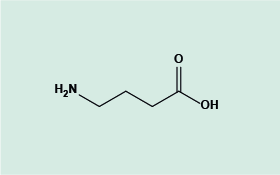GABA, gamma-aminobutyric acid
GABA, γ-aminobutyric acid (Figure 1) is a messenger molecule involved in the transmission of signals along nerve fibres, a neurotransmitter. GABA is essential for the control of the excitability of neurons. In this role, GABA acts as an inhibitor to neurons. It is released in the synapse (the gap between two neurons) and binds to receptors on the next neuron along the pathway of the nerve signal. There it inhibits nerve signal transmission by preventing the neuron from developing an (electrical) action potential, necessary for the travel of the signal further along the nerve fibre.

GABA is established as the most important neurotransmitter in the mammalian central nervous system (the spinal cord and the brain). It is known that at least 40 % of inhibitory synaptic processing in the mammalian brain uses GABA as a neurotransmitter.
In the body, GABA is mostly synthesized from glucose (a sugar) via some intermediate product (glutamate), which is then metabolised to yield GABA. This biochemical synthesis pathway depends on the presence of a particular enzyme (a protein), which in turn requires a sufficient supply of vitamin B6. Accordingly, a vitamin B6 deficiency can lead to a GABA deficiency, which can be a cause of seizures.
GABA receptors on neurons are channel receptors. Upon GABA binding, the channels through the cell / neuron membrane undergo a conformation (shape) change. This opens the channel through the cell membrane and allows ions to pass into the cell. It has been shown that the opening of these channel allows negatively charged chloride ions, Cl-, into the cell. This makes the inside of the cell more negative than when the channel is not open, making it harder to excite that neuron and cause an action potential. GABA binding also triggers the opening of potassium, K+, channels which allow K+ out of the cell. In this way GABA increases the barrier of excitation to the travel of signals along nerve fibres and thus makes GABA a component in the body’s own systems to reduce the likelihood of a pain signal being felt.